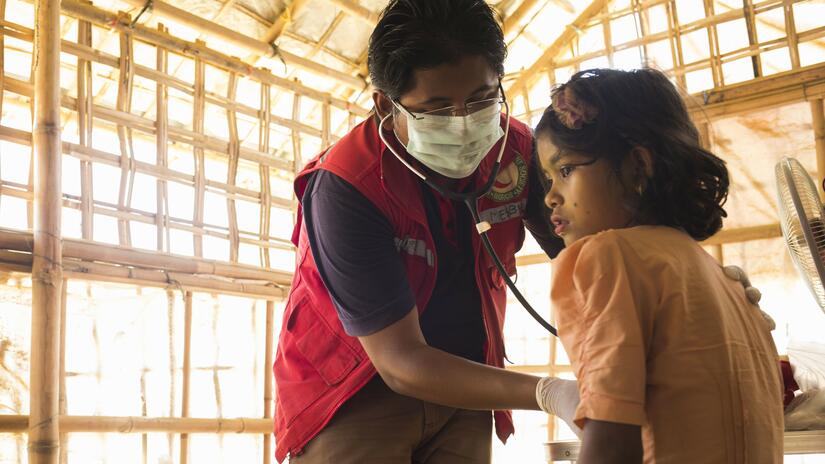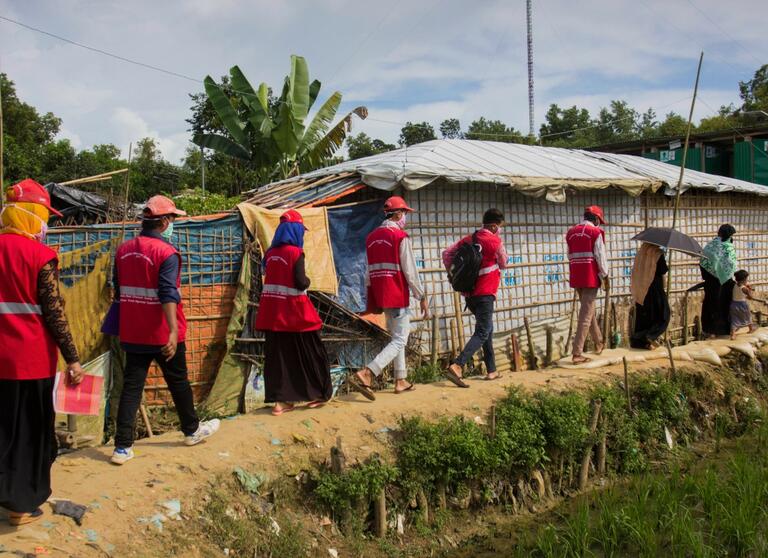I’m an emergency doctor with years of experience yet dealing with a COVID-19 outbreak in the Bangladesh camps is by far the biggest challenge I have ever faced.
I live and work in the heart of the biggest camp for displaced people in the world. Where many live 10 to a cramped room, I sleep in a big tent with one other doctor. Where most homes leak in the heavy rain, mine is watertight. When I rise at dawn, I see morning mists on the hills of Myanmar.
A seven-month-old baby girl tests positive for COVID-19 and becomes one of our first cases. Her family lives among the jigsaw puzzle of bamboo and tarpaulin homes cramped across the hillsides. Our community health volunteers have trekked along muddy tracks to counsel the family.
The baby and extended family are all at risk. It is a difficult conversation involving many family members and finally the parents agree to take the child to our COVID treatment centre.
On arrival, the father is upset and changes his mind about allowing the baby to be admitted. The mother is also distraught as she reveals that she has lost two babies in the past year. She does not want to take any risks with her baby girl. It is heartbreaking to see her pain.
Our health workers counsel the father and it becomes clear that he also fears for himself and despairs for what he will do with no food and no one to cook for him at home. We offer to support him with food as well as providing for the baby and her mother.
Finally, the father agrees that he will isolate at home for two weeks after being in close contact with his COVID-positive child.
The fear about this dangerous disease hangs thick in the air. There is little understanding about the way it is spread. Gaining trust of everyone is a major challenge and is key to tackling the spread of diseases in the camps.
The next day, the father and the baby’s grandfather arrive at our treatment centre and threaten to leave with the mother and their baby. We urgently involve local camp and religious leaders, including the Head Majhi. The meeting is fruitful and again we agree that the baby can receive medical treatment.
Minutes later, a young sick woman arrives for treatment. In the first instance, we diagnose the woman as suffering from a severe depressive disorder and post-traumatic stress disorder. The woman’s husband was killed in front of her in Myanmar and she fled with her two-year-old child. Every day she feels dull and lethargic, and doesn’t feel like doing anything. We arrange longer-term support for the young woman at our larger field hospital.
This woman is almost 10 years younger than me. I cannot imagine what such a young person has been through in such a short life. Her blank stare is void of emotion and it still haunts me when I think about the pain behind her eyes.
Nothing prepared me for these camps. I have been living in a tent for two months. It’s the first time that I have ever lived in a tent and it still feels unreal. But it’s a world apart from the tiny makeshift homes that seem stacked on top of each other along steep hilly slopes.
Privacy that we take for granted is unthinkable. Physical distance is near impossible. Every day our teams stream out along the maze of muddy paths investigating cases and encouraging people to stay safe, particularly contacts of COVID-positive people.
So far, there have been just 78 confirmed COVID-19 cases. Tragically 6 lives have been lost due to this coronavirus, yet it’s a far cry from earlier projections that thousands of lives would be lost.
Life here is harder than most can imagine. Yet I am struck by the strength and sheer resilience of people who get on with making the best of life for their children and those who are frail. I see proud people working hard to make their homes as comfortable as possible. Reinforcing flimsy houses. Making them safer from storms and monsoon rains.
Community volunteers from the camps work alongside aid agencies to build their toilets and water wells. I am struck by the limited number of toilets often far from houses. There is no electricity except for on a few main streets, so women and children face harassment when they use a toilet in the dark nights.
Life here seems unfair for everyone. Young children fetch water from wells. Pumping the wells and trekking with heavy water containers is hard work for the strongest of adults.
In front of our field hospital, I notice two girls around 8-years-old, playing just outside the gate. I am amazed by the house they build out of sand and mud. The house has four separate rooms. I am sure any architect would be impressed with the perfect, straight walls. This model home is a dream for these children. Everyone here deserves to fulfill their dreams of a safer, better life.

133,232,000
CHF Needed to help most vulnerable

87,393,795
CHF currently funded



